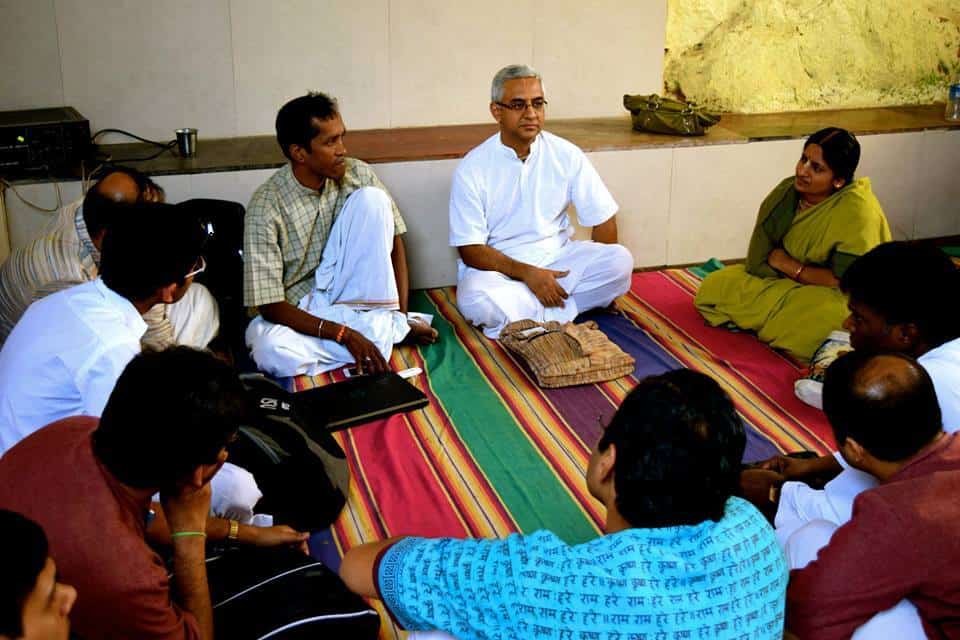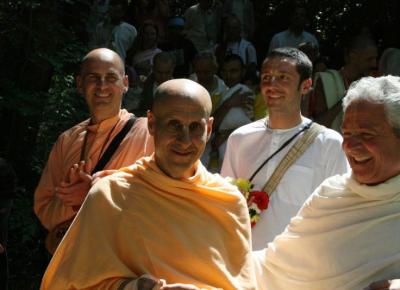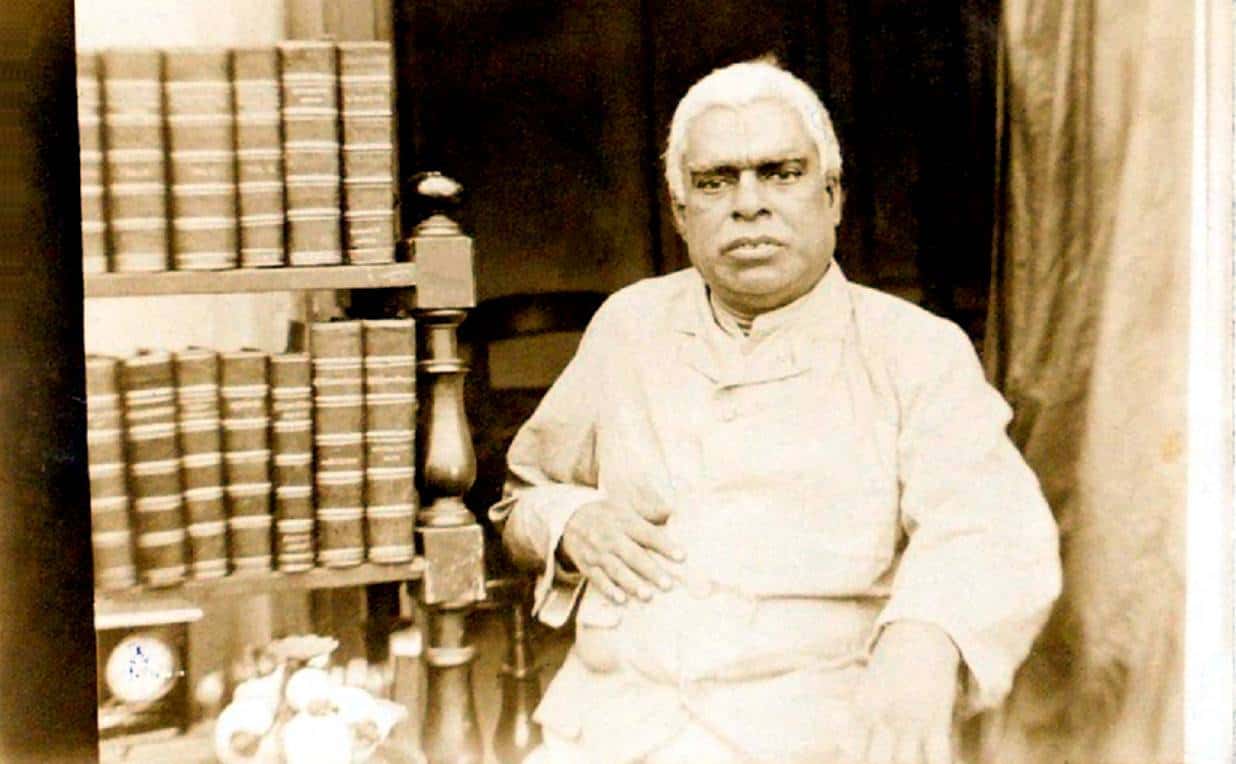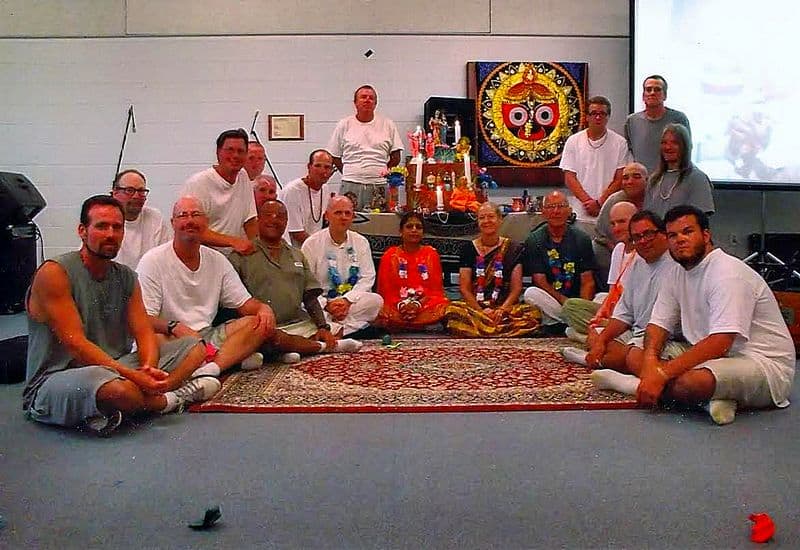Main concepts of the Bhakti-vriksha Program
This is an extract from the Bhakti Vriksha Manual – chapter two.
Why is it called “Bhakti-vriksha”?
In Shri Caitanya-caritamrita, Lord Caitanya and His movement are compared to the tree of devotion, the bhakti-vriksha. Srila Prabhupada writes in his summary of chapter nine of Adi-lila:
“It is figuratively described that both the tree itself and the trunk of the tree are Shri Caitanya Mahaprabhu.… The tree surrounds the entire world, and the flowers of the tree are to be distributed to everyone. In this way the tree of Lord Caitanya Mahaprabhu intoxicates the entire world.”
Srila Prabhupada also says,
“Our International Society for Krsna Consciousness is one of the branches of the Caitanya tree.”
(Caitanya-caritamrita, Adi 9.18)
Every small group of ISKCON’s congregation is therefore a branch of the branch, stemming from the bhakti-vriksha (the tree of bhakti) of Lord Caitanya. The Bhakti-vriksha group is a type of Nama-hatta group that is especially geared toward branching out. Just as in a tree, a branch of a certain thickness branches off into two; and the branching process continues until the tree has thousands and thousands of branches, all connected to the main root. Lord Caitanya is the original root, and even one single branch from the Caitanya tree can grow and form thousands of sub-branches, small twigs, leaves, and so on.
We are part of the Caitanya tree. This is the ISKCON branch, and Srila Prabhupada is our connection.
In different places, devotees call the Bhakti-vriksha groups by different names— Bhakti-sangas, Bhakta-vrindas, Bhakti-cells. What is important is that they follow the principles of the Bhakti-vriksha strategy. Such groups are sometimes called “cell groups.” Cells are the small parts of which our body is comprised. They reproduce and multiply by dividing into two. Similarly, a cell group grows by making new devotees and multiplies into two groups when it reaches fifteen members. We prefer to use the name Bhakti-vriksha rather than “cell,” because the cell analogy simply pertains to division, whereas the analogy of branching includes keeping a connection with the root. Another reason is that the name “cell” is already being used by other organizations, whereas the analogy of the tree of love of Godhead, the bhakti-vriksha concept, was used by Lord Caitanya. So we prefer “Bhakti-vriksha” over “cell.” We adhere to our own tradition.
Somebody may think that we have borrowed this type of preaching from some Christian organizations or from other groups, but actually this is our own original system.
Lord Caitanya used to go from village to village. And wherever He went, each person to whom He preached would branch out and make five more families Krsna conscious. Each of those families would make five more. Such branching is more dynamic than the simple cell multiplication—from one to five is more than from one to two.
Therefore, instead of calling it “cell preaching,” we are calling it Bhakti-vriksha Program, or Bhakti-vriksha Preaching. A tree begins from one small sprout, but when it grows it has thousands or hundreds of thousands of branches. Similarly, from a simple beginning the Bhakti-vriksha groups will grow into a massive affair, as predicted by Srila Bhaktivinoda Thakura.
What is the goal of the Bhakti-vriksha Program? Lord Caitanya said,
“I order every man within this universe to accept this Krsna consciousness movement and distribute it everywhere.”
(Caitanya-caritamrita, Adi 9.36)
The Bhakti-vriksha Program is meant to enable everyone to practice, to grow, and to preach the process of bhakti-yoga. By practicing, the devotee will grow in Krsna consciousness. He or she should also learn how to help others in their Krsna consciousness, so that they will be able to preach to new people. The Bhakti-vriksha Program provides association and spiritual community support, and when the new devotee becomes strong he should preach. One cannot carry out Lord Caitanya’s orders without preaching.
To achieve this in a systematic way requires a great stress on training, on all levels, and on all aspects of practice and preaching. To be successful, the Bhakti-vriksha Program needs to implement a “culture of training.” It is a brahminical, Vaishnava effort, dealing with people’s hearts and minds. It needs ongoing training of every member of every group—by seminars and courses, by practical engagement and philosophical study, by personal development, and by preaching experiences.
What is a Bhakti-vriksha Group?
A Bhakti-vriksha group is a small number of congregational devotees who meet every week to practice Krsna consciousness and to plan preaching activities. In these Bhakti-vriksha groups, the devotees learn how to nourish their spiritual creeper and to cultivate their service attitude in cooperation with others. Every group member is also active in preaching and in bringing new people into the group. Upon reaching fifteen members, the group divides into two. This system keeps the groups small, thus maintaining an intimate atmosphere of personal care and nurturing, which is not possible in large groups. The members help each other under the supervision of a servant-leader and a trainee servant-leader. The trainee servant-leader is being trained and groomed to become the future group leader after the group multiplies into two. Multiplying adds life and increases preaching momentum, compelling new leaders to take initiative. When the group multiplies, the servant-leader continues to supervise one group, while the trainee servant-leader then begins to supervise the other group as a servant-leader. And both of them appoint a new trainee servant-leader.
The group is part of a greater organization of many groups, connected to the temple or to the congregational preaching directorate. The groups are supervised, and the members are guided through a systematic program of training and various extra-curricular spiritual activities.
About small groups, Lord Caitanya said:
dasa-panca mili’ nija dvarete basiya kirtana koroho sabe hate tali diya
“I want five or ten of you to sit together on your doorsteps and chant the holy names congregationally, clapping your hands.”
(Caitanya-bhagavata, Madhya 23.79)
Srila Prabhupada indicated that the way to care for many people is to divide them into groups and delegate leadership to the more advanced:
“That is the way of Indian teaching—that there is one teacher, and how he’s managing hundreds? That means there are groups. One who is elderly student, he’s taking some beginners: ‘Write a or A like this.’ That he can teach. What he has learned he can teach. Similarly, next group, next group. So in this way, one teacher can manage hundreds of students of different categories. This is organization. Not that everything I have to do, I cannot teach anybody to do it. That is not intelligence. Intelligence is that employ others to help you. That is intelligence. Not that “Oh, I was busy. I could not do it.” Why? What about your assistant? Train assistant so that in your absence things can be done.… Everyone should be teacher and student.”
(Conversation, Paris, 31 July 1976)
Each One Teaches Another
Although the group leader takes care of all the members, each new member is also individually supervised by a personal guide, someone who has walked a few steps ahead in his spiritual journey. When a new person joins the Bhakti-vriksha group, the group leader assigns the new person to a particular devotee, to offer association and guidance. This system ensures that the advancement and training of the new devotee is closely monitored. The guide does not have to be super advanced; he might have been practicing for only a few months. This system also gives the guide the chance to repeat what he knows, thus deepening his understanding and realization.
The Weekly Meeting
The meeting has six parts: association, kirtana, japa, discussion, preaching reports and plans, and, finally, prasada. Bhakti-vriksha groups meet every week, on a weekday, in the home of one of the members. However, belonging to a group does not simply mean to attend the weekly meeting; being part of the Bhakti-vriksha Program is a lifestyle. Even after the weekly get-together, the members act as friends, keep in touch with each other, and participate in outreach programs and preaching excursions.
In the weekly meeting, instead of having a formal lecture, the group discusses a particular aspect of the philosophy. Everyone participates and is encouraged to share his understanding of the subject, his realizations, and how to apply that particular knowledge in one’s life. This helps to involve everyone and to make the meeting highly interactive and engaging.
Another characteristic aspect of the weekly meeting is the preaching section, during which the group discusses the preaching activities of the past week and plans for future outreach engagements. Sometimes, instead of the usual meeting, the group organizes a special outing. But the basis of the regular life of the group is the weekly meeting.
Three Types of Community Life
Besides the weekly meeting of each individual group, on Sundays all the groups in the same area join together. This can be in the temple or in any other suitable place, especially if the temple is too small, too far away, or there is no temple in the area.
In these larger gatherings, the focus is on bigger kirtanas, lectures by expert preachers, and training sessions for specific areas of responsibility. This is a different experience of Vaishnava community.
On special occasions, such as Gaura-purnima, Janmastami, or Ratha-yatra, all the groups of the city, or sometimes of the whole country, join together for a grand festival.
Larger gatherings provide the joy and inspiration of practicing Krsna consciousness together with hundreds and thousands of devotees, an experience not available in the intimate setting of the single group. A devotee needs both. Large public programs also give the opportunity to group members to contact and attract many potential new devotees.
All three experiences of community—in a small group, in a larger gathering, and at a big festival—are essential in the life of the devotee. The small group gives the opportunity to share deeply and intimately with close friends. The weekend Sunday Feast or gathering of the groups provides the chance to enthusiastically celebrate with many devotees. Celebrations like Ratha-yatra or the Mayapur-Vrindavana Festival in India, offer the great inspiration of seeing Krsna consciousness practiced by thousands and shared with the masses.
The Structure
The structure of the Bhakti-vriksha Program follows the same format as Srila Bhaktivinoda Thakura’s Nama-hatta organization. It is a pyramidal structure, with the groups at the base. It resembles the banyan tree described in the Bhagavad-gita: the root is up and the branches are down.
Every few groups are supervised by a sector-servant. A few sector-servants are supervised by a circle-servant (up to this level they are all congregational devotees), and so on, for as many levels are needed.
The idea is having close supervision and accountability at all levels. The mood of every leader on any level must be to serve the devotees under his care. A higher position means serving more devotees.
The Broad Strategy
In the broad strategy of congregational preaching there are three phases:
- Contacting
- Cultivating and building lasting relationships
- Commitment
These three phases lead the new person to make a firm commitment to Krsna consciousness by joining a Bhakti-vriksha group, or sometimes a temple ashram, wherein the new devotee is systematically engaged in advancing and preaching.
Everyone—whether residing in a temple or of the congregation—can participate in this preaching strategy. All can help in developing the congregation and making more devotees, by contacting new people and taking their address, by cultivating and building lasting relationships with them, and by training them. The third phase is a committed engagement, such as joining a Bhakti-vriksha group. The atmosphere of such groups may be too intense for some of the very new people, for they may require more time to become familiar with the Krsna conscious lifestyle and values.
Relationship between Bhakti-vriksha Program and the Temple
On the 1st of June 1969, Srila Prabhupada wrote to Tamala Krsna Maharaja:
“The boys and girls from the neighborhood coming to help the temple activities is the good result of our attempts. The temple center is started just to present example to the neighboring residents how they can make a small temple in each and every home. It is not necessary that hundreds and thousands of people will live in our temple, but if we can make effective propaganda, then the neighboring residents, householders, will be inclined to be initiated and follow the modes of temple life. So you encourage the visitors, boys and girls as well as married couples, to understand the value of life and how they can peacefully and happily live if they follow the routine worship method in the temple and establish this in their home to be happy in all respects.”
The temple should be a place where people learn how to worship, learn about Krsna consciousness, and learn how to take up the process of Krsna consciousness and apply it in their own home. If the temple remains only a monastic base for renounced preachers, it risks being sidelined.
We should be careful to ensure that the congregation does not feel neglected and unsupported by the temple. It is important for the temple to take proactive steps for directing the growth of the congregation. When congregational devotees feel such encouraging reciprocation from the temple, they will naturally reciprocate by giving their allegiance and support to the temple. But if the congregation is neglected, they will fail to see the relevance of the temple in their life, and thus their support might dwindle. If the temple becomes the heartbeat, the root of the Bhakti-vriksha tree, providing inspiration, training, and support for Bhakti-vriksha preachers and the congregation, the members will be inspired to come to the temple and to support its activities. The temple will get tremendous benefit from an expanding, enthusiastic, and supportive congregation.
The small Bhakti-vriksha groups augment all the temple programs—Sunday Feasts, festivals, classes, and kirtanas. The Deities and Their worship are naturally the center of the Vaishnava community. The temple’s role is to be a place of pilgrimage, a center of spiritual activities for the whole community, where various samskaras, ceremonies, weddings, and festivities are held, where people come to get rid of material contamination and become equipped to deal with the mundane world in their everyday life.
The first Bhakti-vriksha groups are like children who need encouragement and attention. Initially, someone from the temple must give regular input to develop things properly. In congregational development, supervision is always essential, to ensure that all groups are properly engaged and do not deviate from ISKCON’s high standards. As more levels of responsibility are added, there is less need for direct supervision from the temple.
Temple leaders are invited to see the huge potential of the Bhakti-vriksha Program. They are requested to initiate and supervise its growth. The temples and the whole of ISKCON will benefit from the Bhakti-vriksha strategy.






